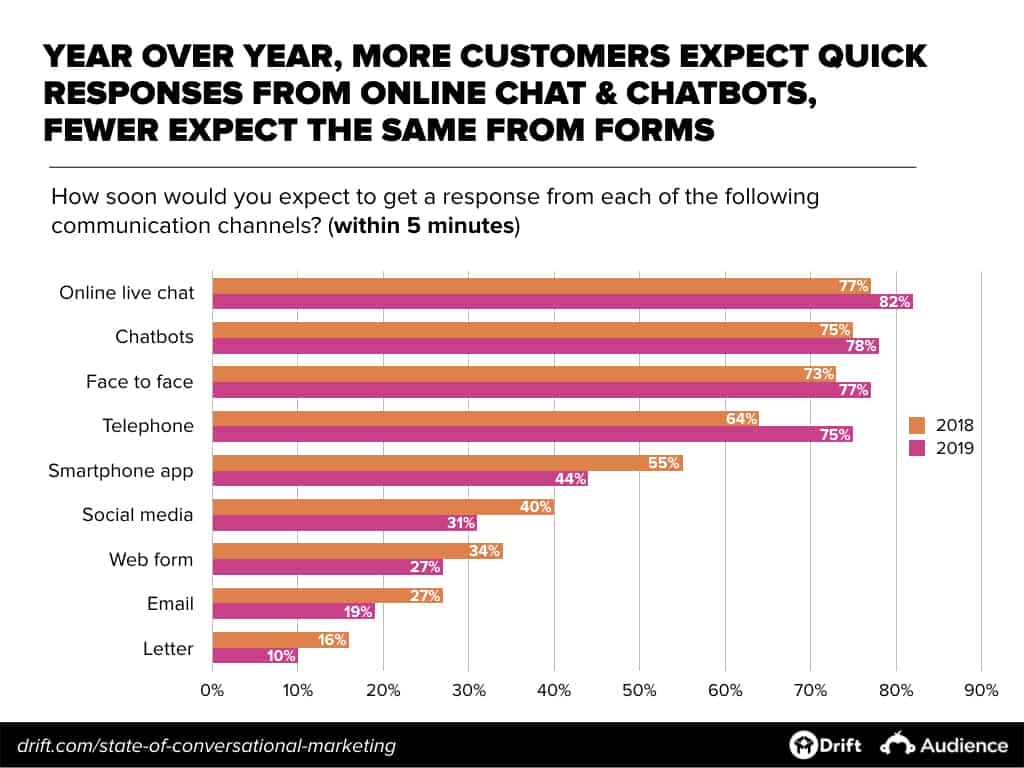What is Conversational Marketing And Why It is the Next Big Thing
In times when everyone can message their favorite brand on social media, conversational marketing is among the top buzzwords for marketers. It is also a go-to approach for Fortune 500 companies that in recent years, enthusiastically invested resources in tailoring perfect customer experiences. They did everything to allow their potential and existing clients to get answers to their questions online as fast as they would get them in a real shop.
However, conversational marketing is not only about customer satisfaction. It’s also about brand opportunities to develop customer loyalty, gather large volumes of feedback, and quickly convert leads into customers without using outdated tools such as robocalls and cold calling.
If you’re on the crossroads to trying to figure out whether your brand needs conversational marketing or not, the short answer is yes. Read this article for more details, insights, and trends on the topic.

What is conversational marketing?
Conversational marketing is an approach that helps businesses provide a higher level of customer service. It uses chatbots and live chats to start conversations with existing or potential clients to engage and build relationships with them. By means of dialog-driven activities, it also helps marketers gather feedback from their audience and build further communication based on insights.
However, conversational marketing does not imply a lack of human-to-human communication. In contrast, it is a complementary tool that helps sales and marketing teams convert leads in the most instant and effective way.
How does conversational marketing work?
As most businesses can now be reached out to directly on Instagram, Facebook, or even WhatsApp, customers want to communicate with brands faster and in a more personalized way. They don’t want to wait for an answer longer than five minutes, not to mention their unwillingness to fill out long forms and wait five working days until they will finally be contacted by a brand via email. Basically, all that buyers want when it comes to online brand communication in a technology-driven world is simply to leave a message and get an immediate and satisfying answer.
Here comes conversational marketing that helps businesses achieve this goal. With tools such as chatbots and live chats, businesses manage to not only drastically shorten the response timeout but also to quickly find out customer pain points and solve their problems in real-time. Data shows that 75% of consumers are more likely to buy something from a company that knows their name and recommends products based on their purchase history. Thus, conversational marketing tools also help ensure that communication is meaningful to buyers.
The key benefits of conversational marketing
It allows for quick adaptation to crisis situations
Conversational marketing is a relatively new approach but yet, it offers a lot of benefits and opportunities to businesses and their owners. This became particularly evident during adjustments with quarantine. When the entire world went digital, communication through live chats and chatbots turned out to be an effective and the only safe way to build relationships with customers. Moreover, it proved to be a preferred option, as 79% of people said they would like to use messaging apps to get customer service.

Brands that have already used or at least got familiar with the conversational marketing approach before worldwide lockdowns, found themselves in a winning position in relation to those businesses that stayed loyal to traditional marketing tools. Considering the inevitable impact of the pandemic on every sphere of our lives and the fact that the world will never be the same, brands should definitely look into conversational marketing tools to adjust to new market tendencies.
Conversational marketing helps increase conversion rates
According to the Drift report, one of the main reasons why customers prefer conversations over filling out forms is speed. Interestingly, they expect chatbots to give answers as quickly as they would get them during human-to-human communication. Moreover, conversational marketing tools are more convenient than traditional methods such as phones or emails. You won’t be held on the line for an unknown amount of time and you won’t have to step outside your comfort zone to talk to unfamiliar people if you don’t want to.
Live chat, a conversational marketing tool, provides an opportunity to communicate with a brand representative online and get answers to your questions in a matter of minutes. What this means is that conversational marketing tools help you satisfy the needs of your customers and increase conversion rates by 45%.
This approach is also used to improve customer satisfaction
Customer satisfaction is crucial for the success of a business. It helps you get loyal clients and become a trusted market player. Research shows that every dissatisfied customer shares their experience with 5-10 people on average and 13% of those people continue disseminating the negative feedback to others. Considering the power of the word of mouth (including social media) and stats that 92% of people trust recommendations from their family and friends, dissatisfied clients are nothing good for your business.
However, customer satisfaction is not only important in terms of products or services you sell. The buying experience is also a valuable interaction with a brand and it should be flawless for your potential client. Conveniently, conversational marketing is one of the key approaches for improving customer satisfaction. By implementing it into your marketing strategy, you make sure that you communicate with your clients in a way that they’re most comfortable with. The effort you put at this stage will later result in greater brand loyalty, better brand image, and of course, trust.
Conversational marketing tools to achieve your goals
Chatbots
A chatbot is an artificial intelligence software that finds out the basic needs of a user and helps address them. It simulates a real conversation with a customer through a conversational interface (CUI). Chatbots are integrated into messaging apps like Facebook Messenger, WhatsApp, Viber, and WeChat. They help clients quickly solve their problems and turn out to be a preferred way of communication (only 14% of respondents said they’d prefer to fill out a website form).
Indeed, chatbots gained momentum in the last couple of years among younger generations like Millennials and among older ones like Baby Boomers as well. Chatbots are expected to solve problems from start to finish, providing answers to simple questions and customer service, ensuring that communication is easy at every step of the way.
Neil Patel, a marketer and entrepreneur, said in his blog that his experience with Facebook Messenger bot has changed his outlook on digital marketing. Seeing metrics such as 88% open rate and 56% click-through rate was unexpected for him so he plunged deeper into the issue and figured out the following benefits of messenger chatbots:
- Chatbots deliver messaging sequences just as emails do.
- A sales funnel can be created right within a messenger.
- Downloads can be sent via messengers.
- Using AI, you can have automated conversations with your potential clients.
However, chatbots are still less popular tools than live chats, for example. The main reason for that is that there are perception and trust problems in relation to them. It turns out that not all people who engage with chatbots always realize they engage with one. In addition, most people don’t trust chatbots and use them exclusively as question-answer machines despite their multi-purpose potential and absence of the possibility of human error.
Live chats
Live chat is an online software for delivering customer services. Unlike chatbots, live chats allow for conversations with a real person in real-time. Usually, a buyer communicates with a brand representative from sales, customer support, or the marketing team.
Recently, the live chat option was the most popular conversational marketing tool for businesses, as it helps improve customer experiences. Precisely, live chats have the highest satisfaction level (73%) among other channels.
Not surprisingly, 71% of businesses believe live chats will become a top tool by 2021. Stats show that they get 15 times more engagement than email. What this means is that people who reach out to brands via live chats are already interested in building a relationship and are more likely to be converted into clients. Another reason for this is that live chats allow people to multitask and not concentrate on a phone call or any other traditional way of communication with a brand. Also, 22% of users said they prefer live chat because they simply don’t like talking on the phone.
Nevertheless, live chats have their disadvantages. Because customers expect live chats to be the quickest channels to solve their problems, there’s an issue with personalization. Given the lack of time, live chat specialists might concentrate on instant problem-solving rather than ensuring that the communication is refined and well-personalized. Another annoying thing about live chats is internet connection. People get frustrated when their conversations are interrupted or disconnected completely. In addition, customers get annoyed when they need to put effort to start a live chat, in particular when they need to fill in the pre-chat forms.
Although chatbots and live chats have their cons, they are the next big thing for businesses operating in a highly digitized world. For this reason, let’s have a look at two conversational marketing trends and figure out where the approach is heading in the following years.
Trends in conversational marketing
Customer experience will be more optimized
Customer experience will get optimized even more, as 76% of marketers state that improving CX is a high or critical priority. It shouldn’t come as a surprise that qualified specialists in Customer Experience Design are in demand among Fortune 500 companies. What this means is that one of the future goals for businesses is to optimize customer experience by means of conversational marketing tools.
For instance, chatbots will become better designed. Businesses will invest in images, videos, and copywriting to give apps more personality and a tone of voice fitting to the brand. Despite remaining a machine-to-human interaction, with tailored UX writing and visuals, chatbots will better fit the platform environment and ensure an engaging but also ambient experience for customers.

Voice-based chatbots will prevail
The popularity of smart speakers and other voice technology is growing and there’s no doubt voice-based chatbots will become the next big trend for businesses. This is due to the fact that customers are constantly looking for more convenient ways of communication with brands, and listening to a chatbot’s answer is definitely easier than reading when multitasking.
Voice-based tools are a great solution for businesses who are ready to invest resources in the improvement of their customer experience. Voice communication between a brand and its client will definitely ensure that communication is more intimate, ambient, and, thus, personalized.
To sum up
Although conversational marketing is a relatively new approach, it gained popularity in the last couple of years. This is due to the tendency that savvy customers are looking for exclusive brand experiences that satisfy their needs but also save them time and effort. The worldwide pandemic has also greatly influenced the relevance of conversational marketing, as its tools turned out to be the best for safe and quick communication between brands and clients. In the nearest years, the situation is unlikely to change.







